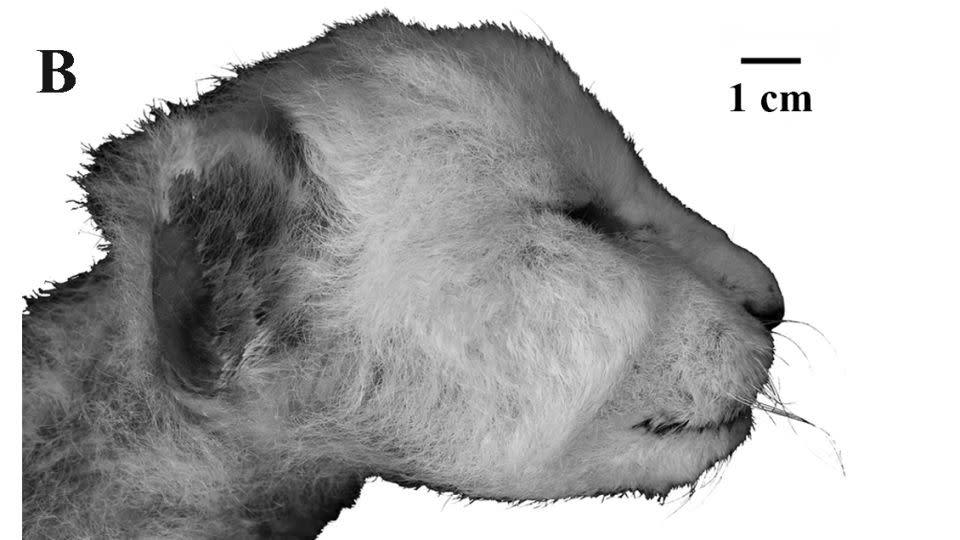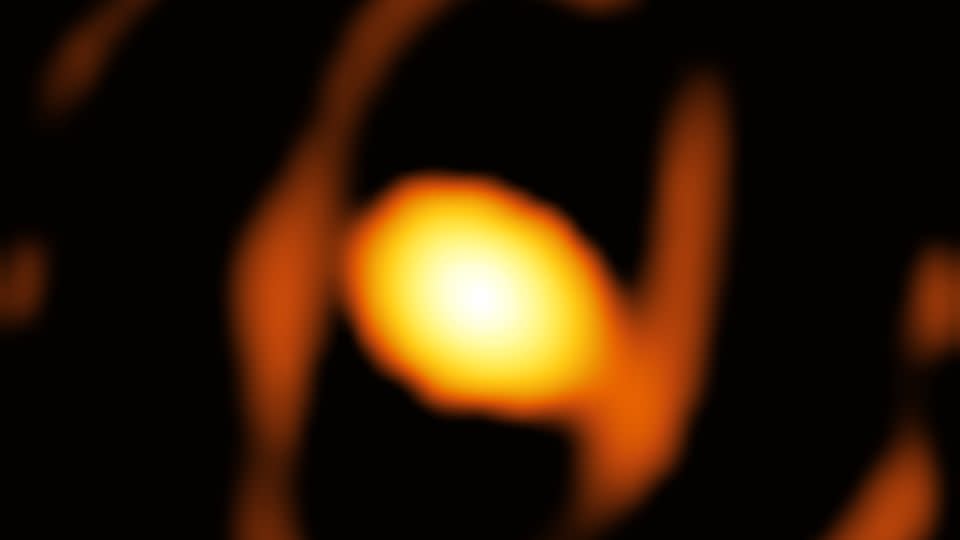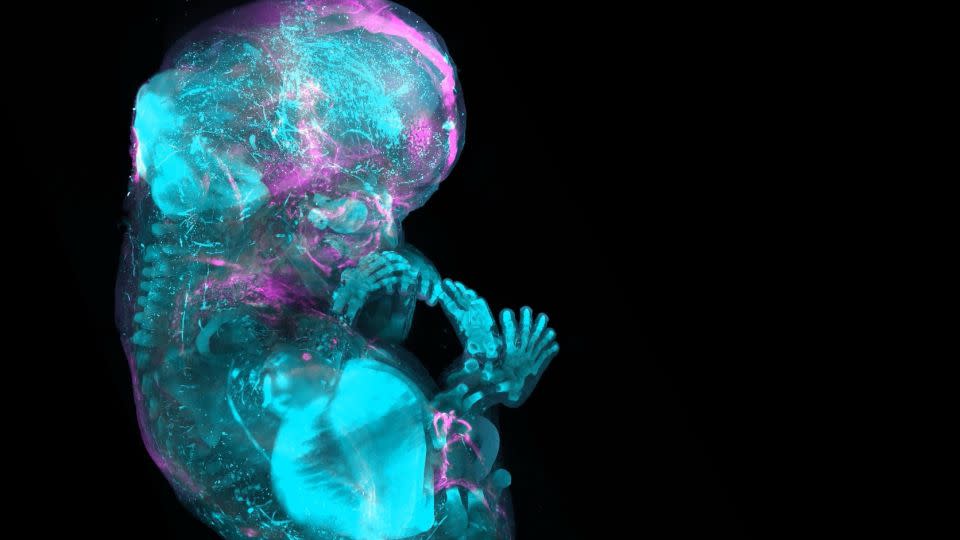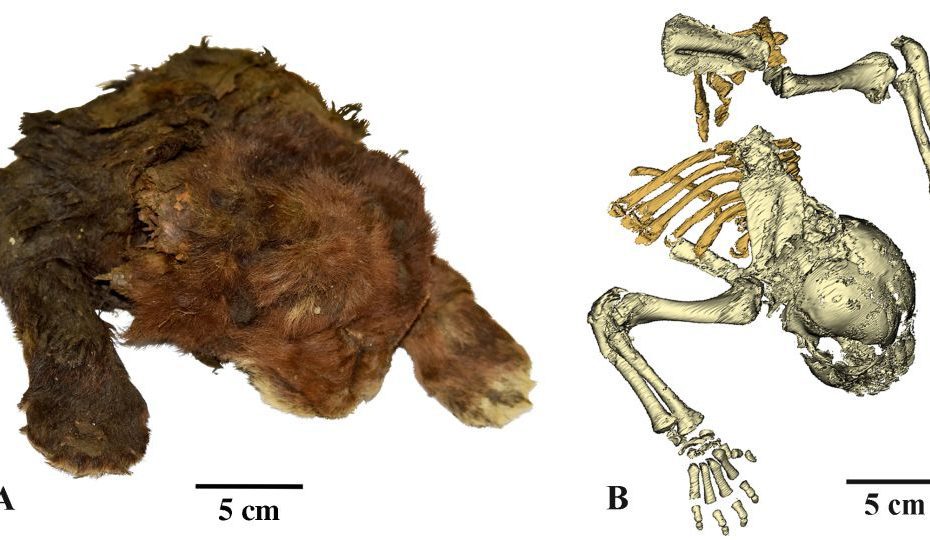Editor's note: A version of this story appeared in CNN's science newsletter Wonder Theory. To receive it in your inbox, register here for free.
Woolly mammoths, giant sloths and saber-toothed cats were a fact of life for early humans.
But today's researchers can only hope to find fossils that will shed more light on the existence of these fascinating prehistoric mega-creatures – and why they went extinct.
New clues found in Earth's northernmost regions are helping piece together portraits of these animals like never before, as the Ice Age continues to surface due to thawing permafrost.
Fantastic creatures

Scientists compared the mummified saber-toothed baby cat (top) with a modern lion cub (bottom). – thanks to Prof. Alexey V. Lopatin
Paleontologists who have discovered the first known saber-toothed cat mummy during excavations in Russia's Yakutia region. The cub was only about 3 weeks old when it died about 35,000 years ago.
The well-preserved remains, uncovered in the Siberian permafrost, are virtually intact, including surprisingly soft fur and even the 'toe beans' – as cat enthusiasts call the paw pads of cats – on the front paws.
It is the first evidence from Asia of Homotherium latidens, and the genetic information from the specimen will help researchers better understand how the species lived and hunted.
Compared to modern lion cubs, the baby cat mama's anatomy revealed striking differences, including darker fur, smaller ears and peculiar adaptations to accommodate enormous incisors that it never had a chance to grow.
Ocean secrets
The search continues for Amelia Earhart's missing Lockheed 10-E Electra plane in the Pacific Ocean after promising sonar images released in January turned out to be an airplane-shaped pile of rocks.
The anomaly was initially spotted on the seafloor about 100 miles (161 kilometers) from Howland Island, where Earhart was expected to land more than 87 years ago.
But a subsequent visit to the site in early November showed that the object was a natural rock formation and not a sunken aircraft.
“Talk about the cruelest formation ever created by nature,” said Tony Romeo, CEO of exploration company Deep Sea Vision. “It's almost like someone put those rocks in this fun little pattern of her plane just to mess with someone who's looking for her.”
Throughout the universe

A dusty cocoon and potential donut-shaped dust ring are seen around the star WOH G64 in the first close-up of a star outside our Milky Way. – K. Ohnaka et al./ESO
Astronomers have captured an unprecedented image of a star beyond our Milky Way, and the striking observations reveal what may be its final death throes.
The red supergiant star, called WOH G64, is located about 160,000 light-years from Earth in the Large Magellanic Cloud, which orbits the Milky Way. The close-up image shows an egg-shaped cocoon of dust and gas surrounding the star, as well as an outer ring of dust in the shape of a doughnut.
Red supergiants shed their outer layers before exploding. “If this is what we see (WOH G64) doing, we're in for a spectacle soon,” said Jacco van Loon, director of the Keele Observatory at Britain's Keele University.
And some astronomers think the explosion will be visible from Earth when it happens.
Other worlds
According to new research, Earth may have had a rocky ring – similar to Saturn's – about 466 million years ago.
At the time, our planet experienced numerous meteorite impacts, many within 30 degrees of the equator, leading some scientists to believe they hit the planet after falling from a potential ring.
The hypothesis could also help researchers deduce why Earth experienced one of the coldest global deep freezes, which could have been caused by the ring's shadow.
In addition, Kelly and Zach Weinersmith, authors of the recent book “A City on Mars,” suggest that numerous challenges, including reproduction, will undermine SpaceX CEO Elon Musk's intention to settle on the red planet within the next thirty years .
Pioneers

A 3D rendered image of a developing skeleton shows cartilage and bone. – A.Chédotal/R. Blain, Institut de la Vision, Paris/MeLiS UCBL HCL, Lyon
Thousands of scientists have analyzed more than 100 million cells from more than 10,000 people to make a giant leap forward in understanding the human body.
It's part of an ambitious effort to create an atlas of every type of cell we possess – which is quite an achievement when you consider that each human has more than 37 trillion cells.
The research teams discovered information about an organ that influences the functions of the immune system, mapped all the cells of the intestine and produced a blueprint of how skeletons form in the womb.
“The challenge we've had is that we didn't know the cells well enough to understand how variants and mutations in our genes really affect disease. Once we have this map, we can better find the causes of diseases,” said Aviv Regev, co-founder and co-chair of the Human Cell Atlas.
Explorations
Traveling this weekend? This intriguing read will help fill the time:
– SpaceX aborted a long-awaited capture attempt of its rocket booster after the launch of Starship's sixth test flight, just weeks after achieving the feat the first time. But the spacecraft still reached new milestones during its last short journey.
— A well-preserved knife handle in the shape of a gladiator was unearthed at Hadrian's Wall in northeast England, and the rare artifact sheds light on the celebrity status of ancient Roman warriors.
— The Solar Orbiter mission has captured new images of bursts of solar activity and the highest resolution of the Sun's visible surface ever seen.
Do you like what you read? But there is more. Sign up here to get the next edition of Wonder Theory in your inbox, brought to you by CNN Space and Science writers Ashley Strickland, Katie Hunt And Jackie Wattles. They find wonder about planets outside our solar system and discoveries from ancient times.
For more CNN news and newsletters, create an account at CNN.com

